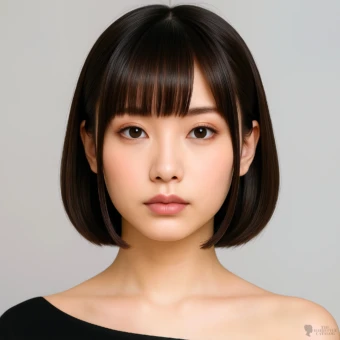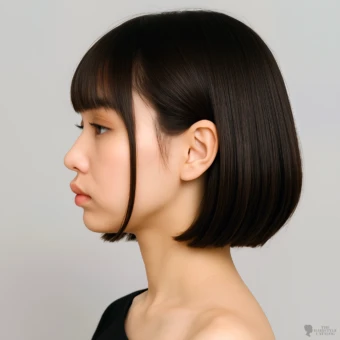Hime Cut Bob – Timeless Japanese Elegance Meets Modern Chic for a Stunning, Feminine Look
Summary
The Hime Cut Bob is a striking fusion of two iconic styles – Japan’s centuries‑old princess cut and the classic bob. This modern hairstyle features cheek‑grazing sidelocks and a smooth frontal fringe cut into a jaw‑length bob, giving it a regal yet contemporary look. Originally worn by noblewomen during Japan’s Heian period, the hime style has re‑emerged through manga, anime and K‑pop idols and, when combined with the easy‑to‑wear bob cut, it creates a face‑framing shape that flatters many face shapes. Its blend of heritage, precision and modern edge makes the Hime Cut Bob a popular choice for fashion‑forward wearers seeking a statement cut.
The Hime Cut Bob
A traditional bob is a short‑to‑medium haircut where the hair is cut straight around the head at roughly jaw level and is kept above the shoulders. The Hime Cut Bob keeps this bobbed silhouette while adopting hallmark elements of the hime cut: long, straight hair at the back is replaced with a bob length, and two sidelocks are cut bluntly at cheekbone level or just below. These side pieces have sharp tips that point toward the jaw, framing the face and creating a balanced look for round or square faces. The style is often finished with a straight, eyebrow‑grazing fringe that continues the strong horizontal line, though some versions omit bangs altogether and let the cheek‑length sidelocks do the face‑framing. Because the cut depends on precision and crisp lines, it works best on straight hair; wavy textures must be blown out or straightened, otherwise the natural wave can disturb the strong lines. Hairstylists recommend regular trims every three to four weeks to maintain the sharpness and symmetrical graduation of the sidelocks and bob.
Compared with a conventional hime cut, which leaves the back hair long, the bobbed version is easier to manage while still delivering the distinctive princess‑like appearance. The cheek‑length locks draw the eye to the jawline and cheekbones, while the bob exposes the neck for a fresh, modern profile. Some wearers add subtle highlights or play with textures – sleek and straight for classic elegance or softly tousled for a contemporary twist. The cut can also be adapted into an “hime lob” where the back length is left slightly longer to sit at collarbone level, offering additional styling versatility.
Hime Cut Bob Hairstyle Overview
| Hairstyle Properties | |
|---|---|
| Alternative Names | Hime Bob |
| Hairstyle Category/Subcategory | Bob / Blunt |
| Complexity | Moderate |
| Hairstyle Volume | Sleek/Flat |
| Symmetry & Balance | |
| Texture Finish | |
| Parting/Hairline | |
| Bangs/Fringe Type | |
| Face Enhancements | |
| Hair Suitability | |
| Face Shape Suitability | |
| Hair Length Suitability | |
| Hair Structure Suitability | |
| Hair Thickness Suitability | |
| Hair Curl Pattern Suitability | |
| Hair Health Suitability | |
| Color Treatment Suitability | |
| Practicality | |
| Styling Difficulty | Intermediate |
| Time to Style | 10 to 15 minutes |
| Maintenance | High (Regular Salon Visits) |
| Durability | Up to 10 hours |
| Styling Methods | |
| Styling Tools | |
| Styling Accessories | |
| Other Properties | |
| Gender | |
| Age Group | |
| Occasion | |
| Cultural Origins | |
| Era of Popularity | |
| Special Tags | |
| In Collections | |
Origin, History & Cultural Influence
The hime cut traces its roots to Japan’s Heian period (794–1185). Sources from Yamano College of Aesthetics note that noblewomen in the imperial court wore shoulder‑length amasogi styles; when a woman came of age, hair around her ears was cut in a ritual called binsogi, leaving short sidelocks while the rest of the hair remained long. Over time, the combination of long flowing hair with cheek‑length sidelocks and a straight fringe became known as the hime cut (“princess cut”). Maintaining such a cut required significant effort and symbolized status and refinement, which is why it was associated with aristocracy and later retroactively dubbed the “princess cut.” The style reappeared in popular culture in the 1970s when Japanese idol Megumi Asaoka adopted it as her signature look, and it became synonymous with kawaii fashion and Lolita subculture. High maintenance remains part of its heritage – the sidelocks and fringe need regular touch‑ups and straightening to preserve the crisp lines, and humidity can distort the shape.
The classic bob cut has a very different origin. In the early twentieth century, Polish hairdresser Antoni Cierplikowski (Antoine de Paris) popularized the short bob inspired by accounts of Joan of Arc. Cut straight around the head at jaw level with a fringe, it became a symbol of independence and modernity among Western flappers in the 1920s. The bob saw revivals in the 1960s thanks to stylists like Vidal Sassoon and remains a perennial fashion staple. By fusing the bob’s strong outline with the hime cut’s princess‑style sidelocks, contemporary stylists created the Hime Cut Bob—a hybrid that marries Japanese tradition and Western modernism. This hybrid first gained attention in Japan, where salons experimented with shorter versions of the hime cut and promoted it as a hime bob. Experts describe the hime bob as an “exotic hybrid” distinguished by long side locks and a full fringe.
In recent years, the Hime Cut Bob has surged in popularity beyond Japan. K‑pop idols and anime characters have introduced the hime cut to new audiences, and the bobbed version offers an accessible entry point for those who find long hime hair impractical. Publications note that the style has trended on TikTok and appeared on runways and red carpets—artists like Taylor Swift and Selena Gomez have sported feathered versions—and its graphic, face‑framing quality translates well on screen. As a bold statement combining contrasting lengths, the hime bob fits into a broader resurgence of retro looks reimagined. While the cut draws from a specific cultural tradition, commentators argue that acknowledging its Japanese origins and referring to it by its proper name helps avoid cultural appropriation. Today, the Hime Cut Bob embodies heritage and experimentation—honoring the elegance of Japan’s Heian court while offering modern wearers a versatile, eye‑catching hairstyle.
Styling Instructions
-
Prep and assess. Start with freshly washed, blow‑dried hair. If your hair isn’t naturally straight, run a flat iron over it first—this cut depends on crisp, clean lines. Decide how long you want the bob: chin‑level is classic, but you can go slightly shorter or longer depending on your face shape.
-
Section the hair. Part the hair down the middle. Clip the back and crown sections out of the way. Comb the front fringe area forward from the crown; separate two roughly 2‑inch sections from just behind the temples—these will become the side pieces.
-
Create the baseline. Comb the loose hair at the back down and trim it straight across at the desired bob length, using small, precise cuts. Use a mirror or ask a friend to help ensure it’s even and level.
-
Cut the fringe. Comb the fringe section straight down over the forehead. Snip across just above the eyebrows in small increments, checking frequently to maintain a horizontal, blunt line. If you prefer no bangs, skip this step.
-
Shape the sidelocks. Release one of the side sections. Comb it straight down and trim it to just below the cheekbone, angling the tips slightly toward the jaw. Repeat on the other side. These face‑framing pieces should mirror each other; take your time checking the length.
-
Blend and refine. Let down the crown section. Comb through and make sure the transition from the sidelocks to the bob is smooth. Use thinning shears if needed to soften any weight lines, but avoid over‑layering—the cut should look sharp and graphic.
-
Style and finish. Run a flat iron over the bob and sidelocks to seal the shape. Apply a light smoothing serum or styling cream to tame flyaways and add shine. For extra hold, mist a medium‑hold hairspray over the fringe and sidelocks.
Tips for the perfect Hime Cut Bob
-
Choose a stylist experienced with precision cuts if you’re not comfortable doing it yourself; uneven sidelocks can be very noticeable.
-
Straight hair gives the cleanest result. If your hair is naturally wavy or curly, invest in a good straightener and heat protectant.
-
Regular trims every three to four weeks will keep the fringe and sidelocks sharp and maintain the overall shape.
-
A chin‑length bob suits most face shapes. Adjust the sidelock length to flatter your features—slightly longer pieces elongate a round face, while shorter ones highlight cheekbones.
-
Experiment with texture: wear it sleek for a classic look or tousle it with a bit of texturizing spray for a softer, modern vibe.




